A paper in Nature Chemical Biology was retracted, less than a year after it appeared.
The official reason: the authors lost access to raw data. The real reason: their “raw data” was utterly fake. They even falsified the time stamps on their Photoshopped “original data” images.
This story is a warning to all the institutional investigations worldwide scurrying to close a case and to dismiss the whistleblowers because the accused scientists presented a low-resolution picture of a purported gel, microscopy photo or a spectral analysis as “raw data”.
In our high-technology days, everything can be faked as long as nobody cares to look closer.
This was the paper:
Siladitya Bandyopadhyay, Susmitnarayan Chaudhury, Dolly Mehta , Arati Ramesh Discovery of iron-sensing bacterial riboswitches Nature Chemical Biology (2020) doi: 10.1038/s41589-020-00665-7
The study was published on 5 October 2020, its authors came from the Tata Institute of Fundamental Research in Bangalore, India. They claimed to have found an new iron sensing RNA molecule in bacteria, which they called “Sensei – short for Sense iron“, as an institutional press release celebrated, under the heading:
Sensei RNA: Iron fist in a velvet glove
“[…] the researchers then turned into crafty engineers. They tweaked the sequence of the RNA and identified the parts in the clover leaf-like structure that may bind iron. Then, they went one step further and made a small change in the RNA sequence which shifted the competence of RNA from sensing iron to now detect nickel and cobalt.
“This nanoscale engineering of iron sensing that we demonstrate, will hopefully set the stage for designing iron-biosensors which could be of use to both bacterial biology and biomedicine,” explains Arati.
This story is as much about discovery by serendipity, as it is about what the discovery has taught us – the versatility of RNA, the unbending specificity behind an RNA’s frail structure and its ability to sense something as fundamental as iron. What better way to honour it than by calling it Sensei, meaning teacher?”
There was no discovery, the study was completely fabricated. It was retracted in late June 2021. This was the notice:
“The authors are retracting this Article because of issues with data integrity and reproducibility. Specifically, native gel analyses of natural and engineered Sensei RNAs (Figs. 3e and 5c) raised concerns of gel background similarities from different experiments. On learning this, A.R. requested an independent researcher with expertise in RNA research to attempt to replicate the same experiments. We now find that these data are not reproducible. Further, in the in vivo expression analyses, the RpoA control and +J41 western blots (part of Fig 4, Extended Data Fig. 8) raise concerns of gel band duplications. In addition, ITC curves (shown in Fig. 1f and Extended Data Fig. 4b) have raised concerns of inconsistent spacing between successive injections. We no longer have access to the raw data for these experiments and hence are unable to verify the salt-dependent binding affinities of Sensei RNAs.
Given that the key data supporting the iron ion-induced structural changes in Sensei RNAs—a central conclusion of the original paper—are now called into question, we believe that retraction of the work in its entirety is essential. The authors deeply regret this situation and apologize to the scientific community. All authors of the original study have agreed to retract the article and with this retraction text.
A.R. informed the institute about these concerns regarding data integrity, following which an independent inquiry was conducted. The inquiry committee also recommends that the Article be retracted.“

The notice didn’t mention the massive Photoshop fraud, probably to speed up the closure of the case on the publisher’s side. Here a sample of bizarrely fake “raw data” which the authors uploaded as supplementary:
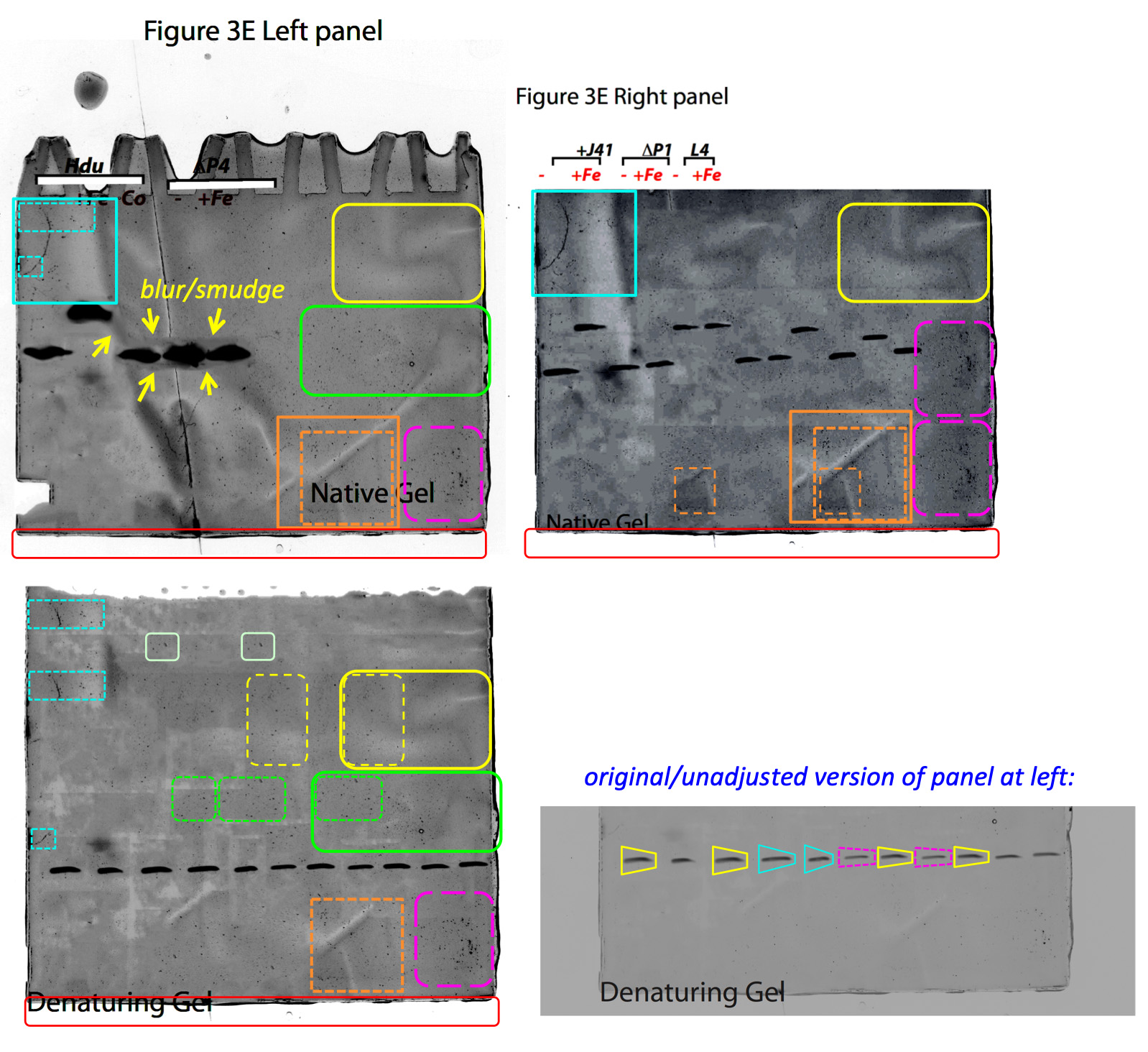
The Bangalore institute’s press release was issued in January 2021, long after the fraud was uncovered on PubPeer. Maybe this is why it ended with this sentence, as an insider joke:
“The real voyage of discovery consists not in seeking new landscapes, but in having new eyes.”
Well said. In October 2020, first criticism was posted on PubPeer by anonymous user Nepenthes Mindanaoensis who used their eyes to make a discovery:
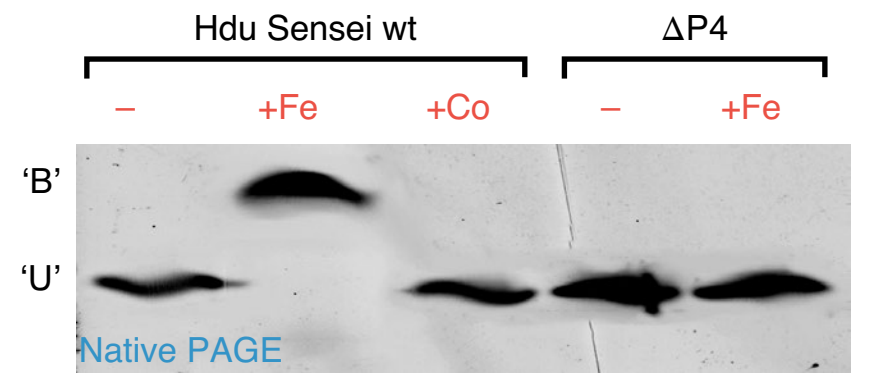
“Lanes 3-5 of Figure 3e are surrounded by a square, making it look like they were copy and pasted from somewhere else. I’m not sure how this can happen?“
A good question. The three bands are clearly digitally pasted. Also, why was nobody at the publisher Nature Publishing Group checking the accepted manuscripts for such blatant irregularities.
Good thing authors of Nature family journals are required to provide raw data like full-length gel scans in the supplemental material. This is where fraud is often found: Spanish martyr saint Carlos Lopez-Otin and Harvard Medical School dean George Q Daley had to retract a Nature Cell Biology paper because its supplemental gel images were found to be very fishy. And in Lopez-Otin’s case, the raw data was not (visibly) falsified, it just didn’t match the corresponding main figures.
So right away, the prolific PubPeer commenter Leucanella Acutissima chimed in with additional findings from the supplementary records of Bandyopadhyay et al 2020, like the analysis shown above. There was more:
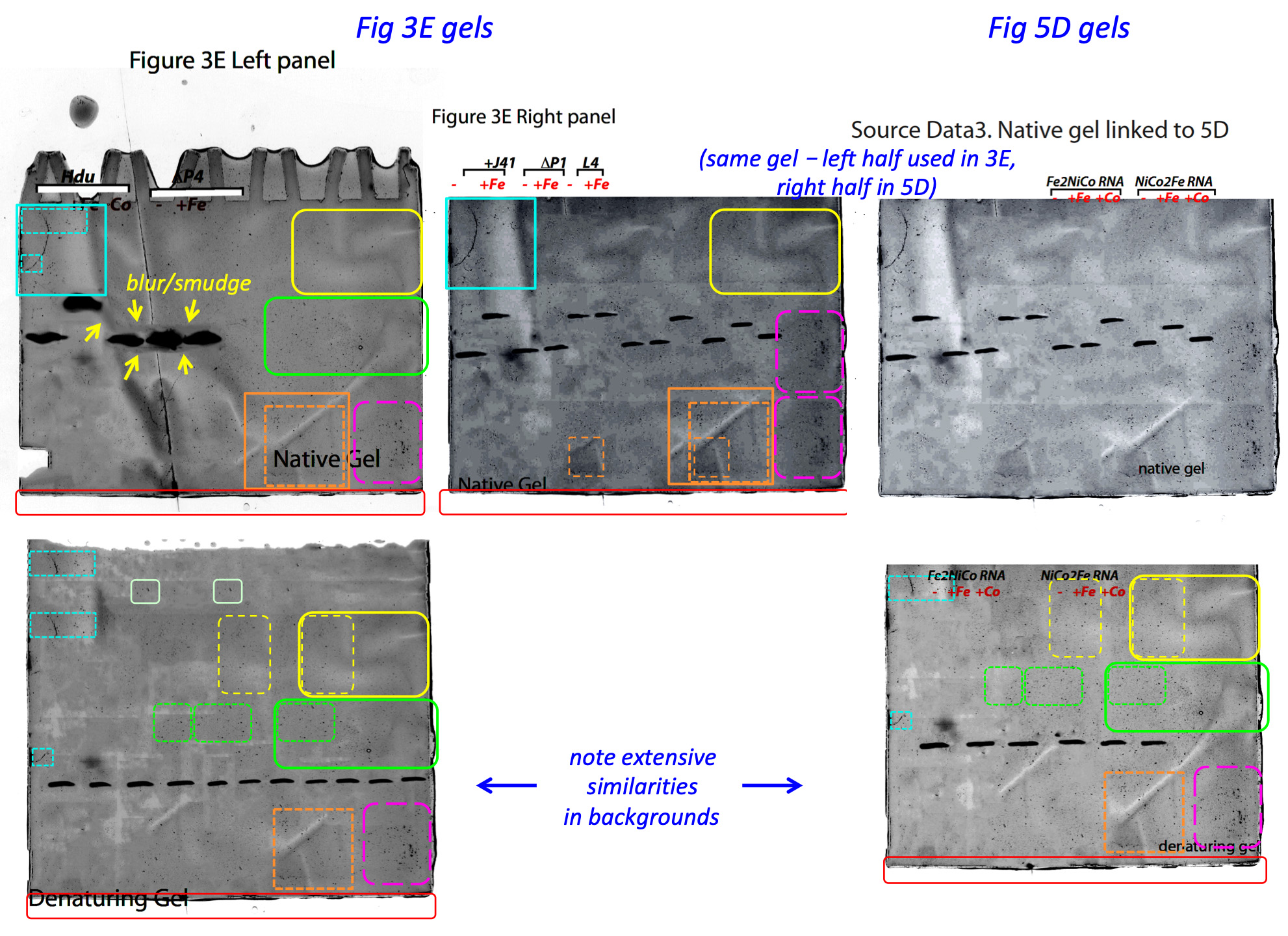
And even more:
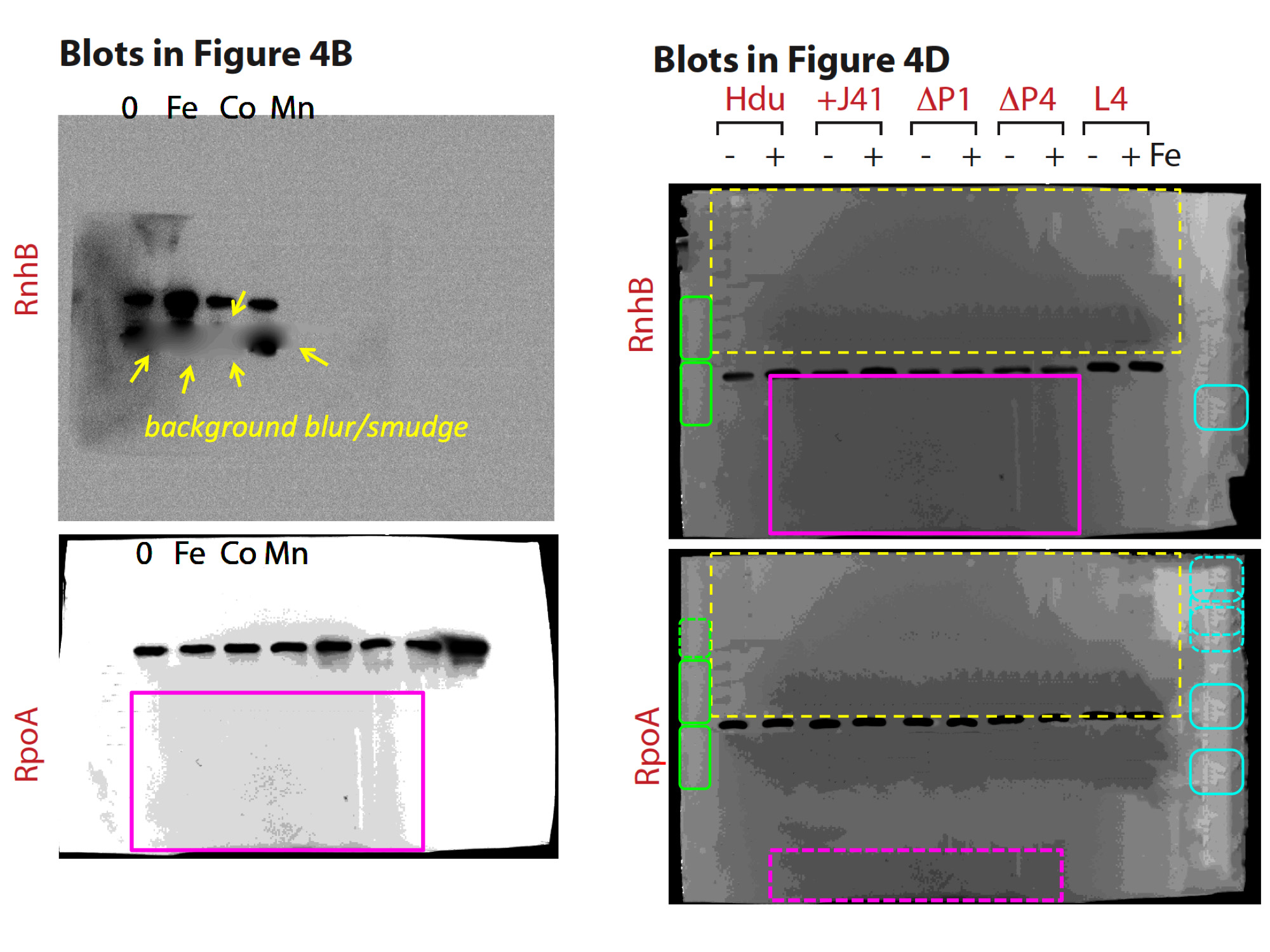
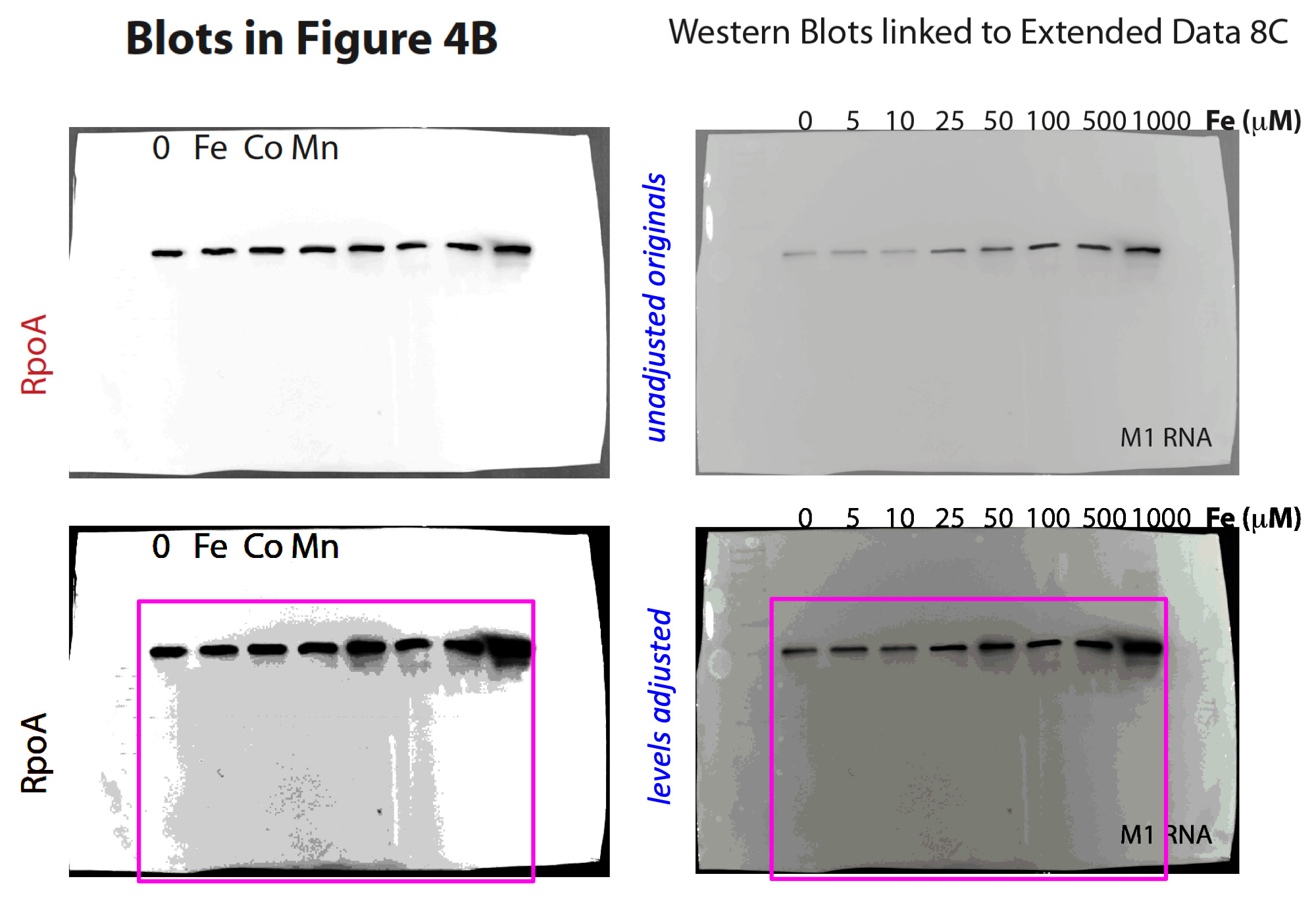
Basically, the “raw data” the Bangalore authors uploaded to satisfy the publisher’s requirements, were fake. Fabricated in Photoshop. But this is not where the story ended.
The next day, last author Arati Ramesh commented:
“We have uploaded the raw images as obtained from the instrument- so that you can rest your concerns. As you can see, we have not manipulated any images. […]
Original images can be accessed from this link (since original files are large in size we are unable to attach them here): https://drive.google.com/drive/folders/1KBP4DDsVoUeZnf7RDeQA7_kX2xazu8NO?usp=sharing Hope these points answer your concerns. The original images are all attached in this response so that no doubt remains.“
This is what the provided “original files” contained:

Fake gel bands were cloned and assembled on a fake gel background in Photoshop:
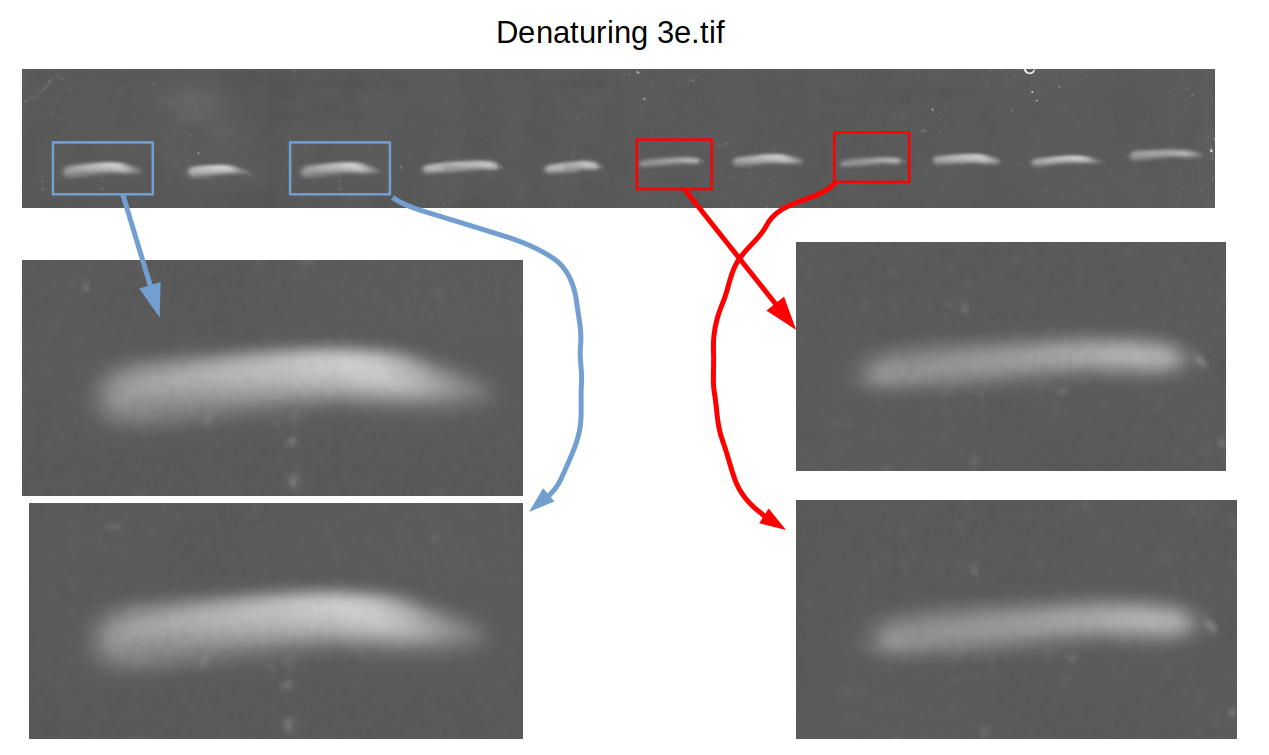
Others found more fakeries in Ramesh’s “original data”, also in the same “Denaturing 3e.tif” file. Here by L. acutissima:

On 2 November 2020, Cheshire informed the journal. Then, someone had a look at the enzyme chemistry measurements, that being chemical engineering paper after all. Why, yes, these plots were fake also, fabricated also in Photoshop probably.

The last author Ramesh pleaded:
“We have submitted all the raw images. These images are procured from the GEL DOC system and have TIME STAMPS showing that they were performed on different days.”
On 11 December 2020, an Editor’s Note was posted by the journal:
“Readers are alerted that the reliability of data presented in this manuscript is currently in question. Appropriate editorial action will be taken once this matter is resolved.”

Ramesh stopped commenting. PubPeer users found more fraud, like this gel picture for Fig 4B, attacked with a smudge tool to remove undesired gel bands:
Had the authors published with another journal, where full-length gels are not required, basically anywhere with Elsevier, nothing would have ever come out. These cheaters may have been too trusting in their digital skills. Their paper was retracted in late June 2021, even if under the pretence of an irreproducibility problem. No reference to PubPeer or Photoshop fraud, the official reason provided by authors:
“We no longer have access to the raw data for these experiments and hence are unable to verify the salt-dependent binding affinities of Sensei RNAs.“
When the fake discovery was published last October, it was celebrated by RSC’s Chemistry World and ACS’ c&en, excited peers were quoted congratulating the authors. The Wire, an Indian online magazine, also reported, but in December added an Editor’s note about the journal’s newly issued notice, and even linked to the PubPeer concerns. The only update c&en ever added was to add a reference to an ACS paper:
“to add a reference to a Biochemistry paper about another iron-binding riboswitch and to remove a quote that implied the Nature Chemical Biology paper is the first to describe an iron-binding riboswitch.“
Priorities, priorities.
Ramesh has her priorities, too. She is already fighting the COVID-19 pandemic. With biosensors, naturally. Without a PCR machine, but with TIME STAMPS, rest assured. Here is her preprint from January 2021:
Anirudh Chakravarthy, KN Anirudh, Geen George, Shyamsundar Ranganathan, Nishan Shettigar, U Suchitta, Dasaradhi Palakodeti, Akash Gulyani, Arati Ramesh Ultrasensitive RNA biosensors for SARS-CoV-2 detection in a simple color and luminescence assay medRxiv (2021) doi: 10.1101/2021.01.08.21249426
It was already endorsed in PreLights by The Company of Biologists, a very respectable publishing society. Indian newspaper The Print quoted Ramesh, who shared the good news that her colour-change test can detect all SARS-CoV2 strains.
While you are reading this, somewhere in the world some dishonest scientist is presently being absolved and whitewashed by their university or research institution because they showed “raw data” to disprove the allegations of data manipulation. The trick is to not look too closely.
Update 8.07.2021
Ramesh is blaming the first author alone, her former student Siladitya Bandyopadhyay, in a public statement:
“The specific data that were flagged came from one author, who left my lab abruptly within a few days after the investigation (without turning in the correct constructs/strains related to this project and without sharing some of the ITC raw data).”
But now Elisabeth Bik found more, whom shall we blame here?
Dolly Mehta , K. Anjali , Arati Ramesh Discovery of ANTAR-RNAs and their Mechanism of Action in Mycobacteria Journal of Molecular Biology (2020) doi: 10.1016/j.jmb.2020.05.003
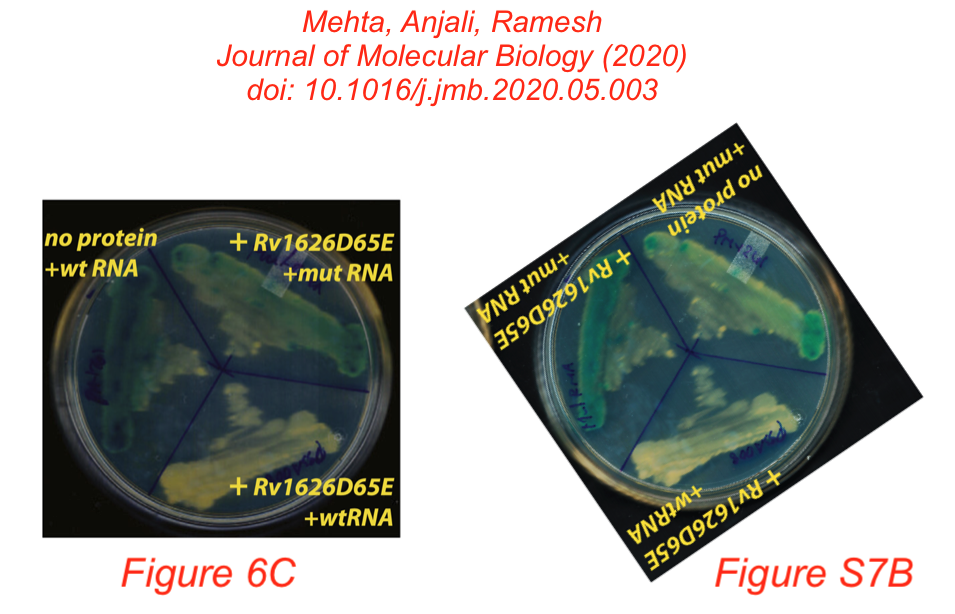
A commenter purporting to be “someone very close to the NCBS community.” alleges in the comment section below:
“Dr Ramesh has a common tendency to pressurize all students in her lab to accomplish experiments in a way that the result matches the bioinformatics prediction. […] Ramesh lab has always been a small lab since most of the students (interns, graduate students or even postdocs) who joined the lab could not tolerate the lunatic environment in the lab for long. There have been several complaints by the departed students for the tremendous mental torture that they faced. But most of the time, the matter remained unresolved for obvious reasons.”
I reached out to Dr Ramesh again.
Update 9.07.2021
Sunil Laxman, group leader at InStem in Bangalore, who also happens to be Arati Ramesh’s husband, explained on Twitter that her paper was never completely fake:
“No. Mostly right. But some things happened beyond twitterverse and the senior author was incredibly brave and did the right thing“
Somebody now looked at his own papers.
Sunil Laxman, Aaron Riechers , Martin Sadilek , Frank Schwede , Joseph A Beavo Hydrolysis products of cAMP analogs cause transformation of Trypanosoma brucei from slender to stumpy-like forms Proceedings of the National Academy of Sciences of the United States of America (2006) doi: 10.1073/pnas.0608971103
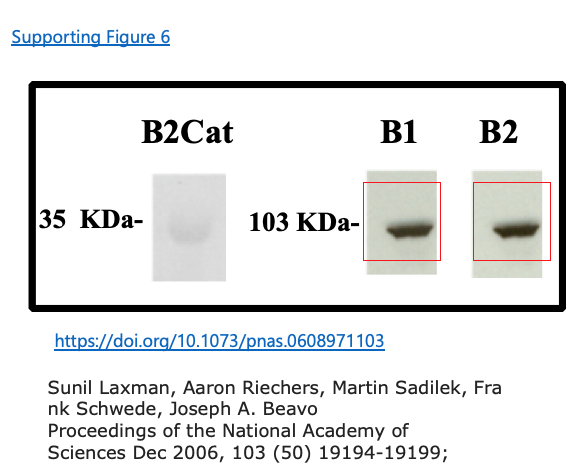
I suggest to do the right thing and blame the first author here?
Sunil Laxman , Ana Rascón , Joseph A. Beavo Trypanosome cyclic nucleotide phosphodiesterase 2B binds cAMP through its GAF-A domain The Journal of biological chemistry (2005) doi: 10.1074/jbc.m408111200

Update 14.07.2021
You know the public version of events. Now how about the behind-the-curtains version, told by internal emails from Arati Ramesh, the rogue student Siladitya Bandyopadhyay, other lab members and the institute’s director? Accompanied by a guest post about Ramesh’s husband Sunil Laxman and his research? Read here.
Update 2.08.2021
Here is my interview with Siladitya Bandyopadhyay:

Get For Better Science delivered to your inbox.
Make a one-time donation
Make a monthly donation
Choose an amount
Or enter a custom amount
Your contribution is appreciated.
Your contribution is appreciated.
DonateDonate monthly
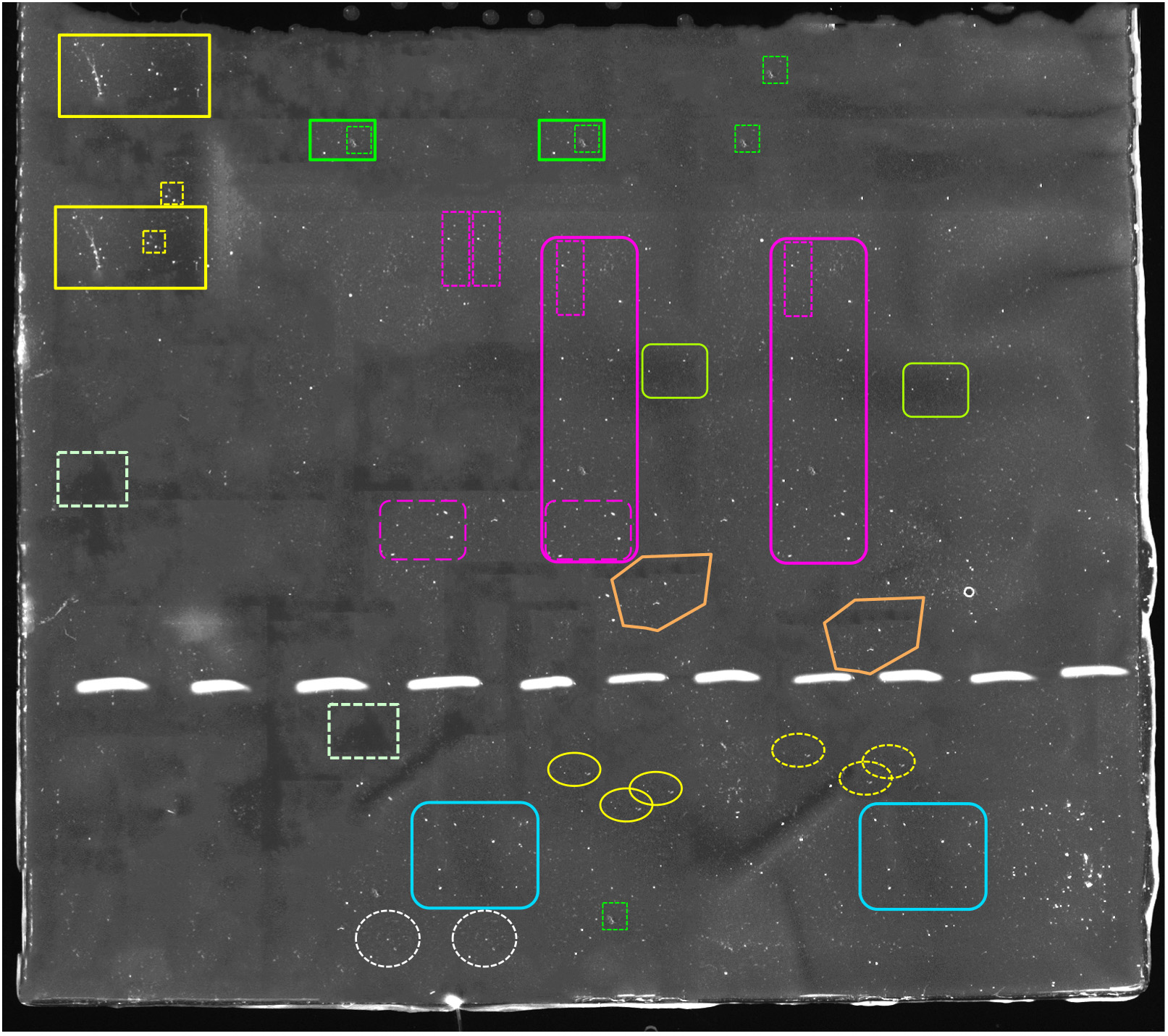


Love this explainer by Professor Sunil Laxman, also from Bangalore:
Someone should have a look at Dr Laxman’s own papers.
LikeLike
Sunil Laxman is the husband of Arati Ramesh.
LikeLike
Thanks for the info!
LikeLike
“The original images are all attached in this response so that no doubt remains.“ Perhaps Dr Ramesh meant “no doubt remains that images are grossly photoshopped”. So yes, the senior author did the right thing, as mentioned by Sunil Laxman.
LikeLike
I suppose that now Adobe’s Photoshop has become an uncapitalized verb “photoshop”, use of it in the latter form imputes no responsibility to Adobe. Still, I feel confident that I could fake data as above just as well with Corel’s rather less expensive Corel Photo-Paint, and there are very likely any number of Linux packages—some even free! Of course, Adobe may like being associated with dodgy research.
Why, by the way, do Deans of prestigious Medical Schools continue to be entrapped by vicious graduate students? It’s really very unfair (though it appears never to have any adverse consequences for such a Dean, nor such a Medical School; strange, that).
LikeLike
The article in question was received on 02 December 2019 and a revised version was received on 29 July 2020. It was accepted on 26 August 2020 and it was published on 05 October 2020. An editorial note / Expression of Concern was published on 10 December 2020.
It was retracted in late June 2021.
The authors state in their retraction note: “We no longer have access to the raw data for these experiments and hence are unable to verify the salt-dependent binding affinities of Sensei RNAs.”
This retraction note does not contain details about the date when the authors have lost access to this set of raw data. So when did this happen? Before or after the manuscript was accepted for publication? Was the journal immediately informed when this unfortunate event took place? How was the situation on 28 September 2020? Was lead author Arati Ramesh at that day already aware that this set of raw data were lost?
This retraction note does not inform readers as well about the circumstances of the loss to the access of this set of raw data. So what has happened? A fire? An earthquake? A lab flooding? Thieves? A broken laptop? Dogs? Gremlins? Brexit? COVID19? Cleaners? An angry co-author? An angry technician? An angry student?
LikeLike
The lead author has uploaded a retraction notice and her personal statement on her lab webpage. It can be accessed at the following link https://aratirameshlab.weebly.com/
LikeLike
Thank you, here it is:

LikeLike
The letter reads like Kelly Clarkson lyrics:
“What doesn’t kill you makes you stronger, stronger
Just me, myself and I”
LikeLike
From reading her statement it looks like Ramesh threw someone lower in the hierarchy under the bus. No surprise there, as it was an “incredibly brave and the right thing (to do).” How honorable.
LikeLike
“The specific data that were flagged came from one author, who left my lab abruptly within a few days after the investigation (without turning in the correct constructs/strains related to this project and without sharing some of the ITC raw data).”
The mysterious perpetrator did turn something in: the fake raw data Dr Ramesh uploaded. It even had TIME STAMPS!
Well, not so mysterious. The person not listed on Dr Ramesh’s lab members page anymore is
“Siladitya Bandyopadhyay (graduate student)“, first author of the retracted paper.
“Here in Arati’s lab at NCBS, I am currently working on iron sensing riboswitches in bacteria.”
https://web.archive.org/web/20210116235451/https://aratirameshlab.weebly.com/people.html
Let me do a wild guess here: until retraction, the entire credit was Dr Ramesh’s, now the credit is entirely the student’s?
Dr Ramesh never replied to my email, sent before this article appeared.
LikeLike
Fraud issues aside, where I work any trainee that stole or destroyed lab materials, lab books, data files, etc. could be arrested for theft and vandalism. There is no substitute for proper laboratory data handling, which is the prime responsibility of the principal investigator. There’s still plenty of room under that bus, no matter who was doing the faking.
LikeLike
Don’t you get?
The data was 100% solid and reproducible, only that the snake stole it, destroyed it, and replaced it with fake data behind the PI’s back to be used in the publication!
LikeLike
The campus is full of snakes, no wonder!
LikeLike
Faking bands were so yesterday, welcome to faking the blot background.
Not related to this paper and this will sound super naive, but can identical noise patterns come from dust specs in the light path/ uneven cooling of the ccd chip? A smudge on a lens for e.g will create similar background noise on microscopy images?
LikeLike
My colleagues had real-life cases like these, with specs etc, they are easily identifiable. No confusion there.
LikeLike
Ya, I think the specs will appear at same position in each blot and will not of course cause the bands that look the same.
I don’t know about indian IP laws if students are paid with a government fellowship, then going awol and data destroying evidence (as the PI alleges) is no longer a misconduct, it’s a crime.
Something tells me the student will remain missing for a couple of years and then will be discovered to be doing a fresh phd in some remote corner of europe/ US
LikeLike
Better yet, the student could make much better money working for a paper mill in China, or create one in India. Has a great CV to get this kind of position. Plenty of good jobs available for individuals with excellent photoshop skills.
LikeLike
It would have been fantastic if Mr Schneider had pointed out these issues with the paper before others did.
Instead, what happened was this:
People on pubpeer pointed the problematic images out in October 2020, soon after publication.
By late November 2020, a committee set up by NCBS had concluded that image manipulation had occurred.
In December 2020,
the journal, at the authors’ request, posted a note of concern.
The NCBS release Mr Schneider cites is dated October 6, 2020 (and edited since); not January 2021 (that’s a copy that appeared on AAAS and for some reason wasn’t stopped or updated).
After the investigation and failed attempts to reproduce the results independently, the PI and the institution requested retraction.
In short, this was handled exactly as it should be, by the PI, the institution and the journal (and also the pubpeer community).
What’s Schneider’s motivation for jumping into this story today, weeks after the journal retracted the paper, and 9 months after concerns were first raised, in an article filled with innuendo but with zero facts that weren’t already reported on pubpeer, ?
LikeLike
Mr Siddharthan, I don’t understand what you protest against, or accuse me of, but not sure you know it yourself.
Do you think there is a big conspiracy, but can’t exactly put your finger on it?
LikeLike
The matter was sorted out back in June with the withdrawal of the paper (which the PI requested back on Feb 1; and since Dec 10, 2020, the article has carried a warning, at the authors’ request.).
You have chosen to write an accusatory piece with no new information and plenty of inaccuracies and falsehoods, not “for better science” but—my best guess is—to further your own notoriety.
What falsehoods? 1. the claim that NCBS promoted it after the problem was known. They did not. 2. the claim that the authors do not acknowledge image manipulation. They do, in their Nature retraction notice (“gel background similarities”, “gel band duplications”), in the official NCBS statement (“The [Nov 23, 2020] report concluded that image manipulation had indeed occurred”) and in the PI’s personal statement (“It was now unambiguous that some of the data had been manipulated”). There is much else that could be called slanderous innuendo at best.
Can we expect a correction from you? No, I thought not.
LikeLike
Wrong Rahul, the case was actually closed by the PI in November last year when she uploaded fake raw data and told everyone to back off. Did you forget?
Then she lied in the retraction notice and her recent online statement that her raw data was somehow stolen by a rogue student. No word again about the fake raw data she herself used for her defense.
Finally, Rahul, on which authority do you order the scientific community to forget this ever happened and to never talk about it again because the paper was already retracted?. You say I am notorious, but who the heck do you think you are, telling people how to think right?
Go play outside, Rahul. Grownups talking here.
LikeLiked by 1 person
Classy as always, Mr Schneider. Thanks for confirming.
LikeLike
What’s Mr. Siddharthan’s motivation for defensing the indefensible? It’s because for him, solidarity with his upper caste brethren is above everything, even research integrity.
LikeLiked by 1 person
Good to know that “this was handled exactly as it should be (sic), by the PI”, by shifting the blame to a student and sacrificing him. The depravity of the system never ceases to amaze me.
LikeLike
On the other hand, the level of blatant mslanipulation is impossible without the students knowledge or content. It is obvious that the student actively participate in the manipulation. I dont belive he was an innocent lamb who was ‘sacrificed’.
You should check from some oldies in ncbs. Once upon a time there was a PI called Manjari Majumder. She tried to fudge data but the student stood up and blew the whistle. The PI was tired quite quickly. The student is a PI now. Dude had spine.
LikeLike
Why are you so convinced that the student did not do it?
Note, I do not absolve the PI: all data should have been checked. But there is a pandemic on and everybody is struggling to get their work done. For that matter, who knows what stress the student was under.
As Notsotoxicsap says, it could not have happened without the student’s involvement. I know the PI a little (and have visited NCBS often and can vouch for the leadership’s uprightness). I do not believe the PI would have pressurised the student to fake data. If any further examples are found in her papers, I will change my tune about that. But going by this case alone, yes, she and her institute handled it in absolutely the correct manner.
LikeLike
Amazing! The lead author who is blamed both by the institute and PI (it is the trend). The lead author joins the institute or Lab in late 2017 October, get trained and do all the major experiments associated with the Nat. Cem. Biol. Paper. Usually such kind of journal requires a fairy tale story and also tons of supporting complex experiments. Then within the 2 years of joining since 2017, the lead author completes all major experiments as claimed by the institute as indicated that is responsible for all major contributor of data and figures which has been manipulated. It is surprising that a new PhD student who just after join the lab within two years is able to do all Things-Get used to the experiments, complex biochemistry, data generation, figure preparation and the alleged figure problems creation, and the PI and Institute NCBS gives all blame to the lead author.
LikeLike
Dear Prof. Dr. Rahul Siddharthan,
You write as follows.
“The matter was sorted out back in June with the withdrawal of the paper (which the PI requested back on Feb 1; and since Dec 10, 2020, the article has carried a warning, at the authors’ request.).”
June was last week. So please stop trying to make it sound like it was “back in the ages ago prehistoric era” and that some journalist with an agenda is raking up the issue with some ulterior motive.
Second, the warning was carried after an issue was pointed out on PubPeer. One of the members there got in touch with the journal. Saying the warning was carried at the authors’ request is disingenuous and whitewashing at its most blatant.
“What falsehoods? 1. the claim that NCBS promoted it after the problem was known. They did not.”
There was a committee constituted which already in November 2020 submitted its report. There was a known problem. It was promoted in January 2021. Please see this link https://www.eurekalert.org/pub_releases/2021-01/ncfb-sri011821.php
Sunil Laxman, Arati’s husband came out in support, calling her brave. “Mostly right”, he said about the paper as if the results being “mostly right” is justification for fraud and data manipulation. What is your relationship with Arati that you are now coming out even more strongly in her support? Full disclosure please.
LikeLike
I have met her a few times and have visited her institution frequently. I have also invited her to speak at a smallish meeting at my institution (15-20 speakers, held every 2 years). In other words, exactly the same relationship as with dozens of other Indian scientists. I am not a collaborator.
LikeLike
Also, as I wrote, the release you link to is from October 2020, not January 2021. Why it appeared on AAAS’s website in January 2021 I don’t know. But the version on the NCBS page is updated.
LikeLike
Here another press release outlet which faked the TIME STAMPS.
https://press-news.org/153062-sensei-rna-iron-fist-in-a-velvet-glove.html
You think the student did it?
LikeLike
Rahul explained to you, the student even faked the TIME STAMPS on the EurekaAlert press release!
LikeLike
Dear Leucanella Acutissima,
I will tell you what Rahul’s relationship with Arati and Sunil is. All three of them are Brahmins, the highest caste in the oppressive Hindu caste system. They are so overrepresented in Indian science (and other fields) that even though they are 3% of India’s population, they make up over 80% of the faculty at places like NCBS and Rahul’s institution, IMSc.
The relationship Rahul has with Arati is of caste solidarity, a relation that overrides everything else in India, even research integrity.
LikeLike
You racist! Join the club. 😉
LikeLike
Hmmm….kind of reminiscent of the disproportionate amount of Jewish faculty in German research institutions in 1932. That did not end well.
In the US, we have a disproportionate amount of faculty who did their post-doc for “famous” people in Ivy league institutions or in California (think Harvard/MIT/Stanford/Berkeley).
The question is this. Do you want the people with plumb faculty jobs only to go to the very smartest, or who worked long hours for the very smartest, or committed fraud with the very smartest, like what is going on now? Frankly, if I could not “make academia great again” by firing the snot-nosed Ivy-leaguers, then at least we could limit their grant money (2 NIH RO1’s max). And fire the ones whose lab where where fraud is committed.
LikeLike
Judging the gusto of this platform, probably the proper response will be GOT/ Cersei style walk of shame for the corresponding author, followed by burning at stake /stoning. Also the institute should be bulldozed flat and /or set on fire.
LikeLike
I just checked Retraction Watch, they don’t write about that case. Seems I missed the memo indeed.
LikeLike
My preferred punishment for faculty gone rogue is to hire a former (and therefore likely unemployed) member of ISIS to whip the delinquent faculty member with a bamboo cane until they drop from exhaustion. Then, stick them in a crate with air holes and send them to Weill-Cornell, where Augustine Choi can give them employment. Then at least we know anything with that stamp is likely fraudulent.
LikeLike
From the information available, it is clear that the PI is certainly utterly incompetent and most likely complicit, and the student is certainly involved, whether out of his own volition or not. Both should have been punished, but of course Indian science elites will give each other character certificates and push the blame on those who are in no position to resist.
LikeLike
Is PI incompetent? You should question the recruitment policy? She has funding from India _Alliance DBT Wellcome Trust – who chose only the best in the world to work in India. Funding from HFSP – do you think they fund “incompetent people”. I question and doubt the selection process of these organisations. More transparency needed. Please look at the selection committee of India Alliance/DBT Wellcome Trust ….
LikeLike
INDIAN SCIENCE WIRE
https://science.thewire.in/the-sciences/ncbs-arati-ramesh-iron-sensing-rna-paper-retraction-research-publishing/
LikeLike
You can criticize whatever. At least this is the first time a PI posted remarks on the institution’s website explaining the situation. I am not familiar with all the universities in Europe. Honestly, in the US it is unthinkable to post a retraction notice on the institution’s website.
LikeLike
e.g. https://www.uky.edu/prmarketing/toxicology
I know very well that America is full of s**t, but it is honestly impossible to exceed the amount of fecal matter lying all around in the ancient holy land of India.
The administrators of NCBS have to be commended for rising above the low bar set by their neighbors at IISc (where the people who created room temperature superconductivity using photoshop are still at large.) At least NCBS acknowledged that misconduct has taken place, and that is good. The record has been set right.
But in the process, they themselves seem to have economized on the truth and let the PI off the hook while shifting the burden of misconduct to a graduate student. Did the committee speak with Siladitya Bandyopadhyay? What is his version of the story? Was it his idea to fake the images? Why did he leave?
Where is he now? We only have the word of Ramesh on the matter.
From my experience working in another TIFR Centre (next to NCBS) about a decade ago, I can guess what happened. But like many other things in India, we can only guess, and will probably never know for sure. But what we can know for sure is that those higher up in the food chain will not suffer any consequences.
LikeLike
I don’t think the PI has been let off the hook in any way. She is guilty of extreme carelessness. But did she commit the fraud? Highly unlikely, otherwise she wouldn’t have posted raw images on pubpeer that in fact make the case worse.
Why finger one particular student? To exonerate the others. That is important. She, as PI, will be associated with this incident for years, but her grad students (other than the one responsible) should not suffer by association.
As for Schneider, he has an agenda. Previously he has posted toxic and borderline racist tweets on Indian science. (He has since been banned from Twitter so I can’t pull them out). Whether he has something personal against this scientist or institution, I don’t know. Thanks for making it clear that you do.
LikeLike
Don’t make stuff up, Rahul. Or do you call my ridicule for Ayurveda racist?
LikeLike
PS – also, the retraction notice did not point fingers at everybody. It was Schneider who dragged them into the mud.
LikeLike
@schneider here is the twitter thread. I don’t remember exactly what you said, but it was some generalization about how Indian students are made to do menial chores for their professors. Multiple people called you out.
Everyone on that thread who calls you out is a scientist, not an Ayurveda defender.
And you called me a Hindu nationalist at one point.
Actually, why did I revisit that? It is clear that you are a toxic person with an agenda, and the agenda is not “for better science”.
LikeLike
Ah, that. It was the debate that students in India often have to provide food and drink for their examiners. Several Indians in the thread confirmed that the practice is widespread. You and some others insisted that criticizing that practice was racist.
Do you expect students to feed you, Rahul?
LikeLike
There you go again.
LikeLike
Nobody claimed that criticising the practice is racist. The practiceexists and is obnoxious. You claimed it is universal in India and used it to demean Indian science generally. I suppose one should be happy that you did not accuse the PI in this case of this.
LikeLike
I will reply to you by quoting someone you used to agree with:
“That comment is weird and I agree with others that it is #racist. Of all the Indian Institutions I have studied at or been associated with, I have not seen one where students are expected to bring food for their evaluation committee members. Stop stereotyping.”
This practice does not exist in India, fact, how dare you claiming here otherwise, Rahul? You racist.
LikeLike
I have personally never seen a banded krait. Therefore they don’t exist in India.
Next time, try not getting banned by Twitter, so that people can verify exactly what you said.
LikeLiked by 1 person
Next time, try not to defend research fraud by your friend and student extortion for food. And no, I am having the last word here, Rahul.
LikeLike
IISc also covered up the other retractions
https://retractionwatch.com/2019/12/16/award-winning-researcher-in-india-retracts-two-papers-corrects-three/
No action was taken.
LikeLike
Seen this?
https://forbetterscience.com/2019/05/29/yogeshwer-shuklas-toxic-career-of-ayurvedic-infusions/
LikeLike
It is not true that the IISc superconductivity data was photoshopped. Data was certainly manipulated but not photoshopped :-). Further, it deserves two Nobel prizes : one for superconductivity and the other for reproducing the noise. The latter is even more commendable than the former.
LikeLike
If I can just have a corner of the sandbox for a moment, I would like to point out that this is not a “cast of thousands” paper listing collaborators from several institutions scattered across the planet. This study came from a single laboratory, and thus each author should have been familiar with the actual data presented, the means of acquisition and analysis, and the scientific significance thereof. While the actions of the institute and the PI have in many ways been exemplary in this case, it is unlikely to end with the scapegoating of an absconding trainee. I can see the bugger coming back and suing the lot of them with publicity like this.
LikeLike
Welcome to the sandbox, Owlbert. I know some PIs who retracted their own papers when the first author committed fraud. They did so voluntarily, often without PubPeer evidence even.
Here is one such case: https://forbetterscience.com/2017/02/27/susana-rivas-a-new-research-integrity-scandal-in-french-plant-sciences/
Here another, very high-profile:
https://undark.org/2020/01/30/frances-arnold-retraction/
These people deserve all respect and support indeed.
But our PI, Dr Ramesh, had no choice but to retract the paper. At best, she is unable to supervise a tiny lab with 3-4 students. She didn’t check the crap she presented at conferences and submitted for peer review. She utterly failed in doing the basic check of that “raw data” she tried to use to squash the debate. She only admitted to problems AFTER the paper was retracted, in fact only after I published this article. She then blamed the student for everything, and before the retraction she used to take full credit for that same achievement.
Am I supposed to think this person is Indian scientific elite, the best India has to offer? Does India have nobody better to do this job? Really?
LikeLike
Dear Leonid Schneider,
India is the land with the graded caste inequality of people, in which the Brahmins are in the topmost position and the untouchables are at the bottom. All the higher positions including academia are mostly occupied by Brahmins and they systemically do not allow others community to enter. Whenever someone talks about system in India, it should be starts with caste because that is how India functions. This is the reason why people are publicly supporting the fraud not the scientific integrity. In particular, 70% academia are occupier by Bengalis and more than 50% of Bengalis are getting position’s only because of their network. In this retracted paper also you could see first and second authors are Bengalis. Dr. Arati Ramesh is Brahmin and they want fame but not ready to do science.
LikeLike
To all those dragging race and caste in their posts, STFU. This paper’s retraction has nothing to do with this. If you have the talent, you can go abroad. There are many in India that migrated to the USA and Canada because of the caste quotas and reservations in India, Most of the Indian universities are populated by these reservations. No talent is required for backward classes, scheduled classes, and the scheduled tribe reservations.
LikeLike
Nothing in India is unrelated to caste. Upper caste Indians aren’t moving to the US and Canada because affirmative action policies in India hurt them, but because they can and it’s a route to upward mobility for them.
// No talent is required for backward classes, scheduled classes, and the scheduled tribe reservations.
Fuck you. Read up on affirmative action and why it is needed.
Well, what about Arati Ramesh and Sunil Laxman? With now it clear that they are data manipulators at worst and incompetent at best, why do you think they were hired at NCBS and InStem? Clearly, it wasn’t for talent.
LikeLike
There is much truth in this comment. I would not say it is caste, but something that is closely correlated: the ability to speak English fluently and affect a “polished” presence. I am not aware of the caste of most scientists (except when they use it in their name; often, not even then) but there are many well-known Muslim scientists, and many of them are of this urbane, polished background. It undoubtedly influences interview committees, promotion committees, etc.
Affirmative action is needed and it works. My state (TN) is an example of it, maybe not in academia (yet), but in many other fields. That said, in my academic institution, its two best-known and best-cited scientists (both retired) are Tamil but not Brahmin.
But anyway, that is a separate discussion. Did I give Arati Ramesh the benefit of doubt because of her caste? Certainly not: I don’t know what her caste is. Because of her manner and articulation? Possibly, unconsciously. I still claim that her initial pubpeer reaction suggests she was genuinely unaware of the fraud. But with this second example, there will certainly be investigation which should be independent and transparent.
LikeLike
To the SICK PERSON
I am in the USA for 35 years. I don’t think the reserved caste can make it here. Regarding the hiring of Drs. Rramesh and Laxman, you should look into their C.V. In the last 40 years of reservations, the Universities are loaded with no-talent reservations. Look up the Indian science achievements or university rankings in the world. Your caste-based myopic view is clear in your posts. One last time for you and others-the retraction has nothing to do with the caste of the authors. Stop polluting science columns and Twitter with your INCOHERENT posts. You are aptly named yourself SICK.
LikeLike
For non-Indians reading this, zmudzka’s comments are exactly the equivalent of white supremacism in the US. The only difference being whites are a majority in the US while upper castes are a small minority in India. Otherwise it’s exactly the same tactic of using historical advantage and oppression to claim superiority, or in Indian English, “merit”. Just saying.
LikeLike
We know, why you (zmudzka) are defending Dr. Arati. That is the same reason, why we need to talk about the caste system here. You have mentioned that many of them who migrated to US and Canada are from the reservation quota. Thanks for accepting the fact that the reserved category (underprivileged) students who got the opportunity in educational institute are capable to get a job in US and Canada with an international competition (which you people always don’t like). The underprivileged students need a chance in educational institute (which were denied for thousands of years in the name of caste). We are not getting a job by networking as like others. You talked about talent, yes we are not buying a talent from costly coaching center’s.
What are the breakthrough researches done in IITs, IISc, TIFR and other research institutes?. How many Nobel laureates are there in the country? Who are the faculty members in these institutes? You people only destroying science by not giving a fair chances to everyone. Can you blame the reservation for the Dr. Arati scientific misconduct?
Even in school/college, we repeated the experiments. Does nobody taught Dr. Arati to repeat the experiments? Now, whole world can see the talent of the un-reserved category researcher.
It is the PIs and Institutes duty to make sure that the students should know all the scientific ethical practices. The supporter of Dr. Arati is clearly indicates the Indian science is rotten and you are exposing by yourself. The sad truth in India is that the most academicians are actually do science/pseudoscience for comfortable living. They do not speak a single word against stupid slogans in Sanskrit. Is it not scientific ethics are more important than the scientific discovery itself? Is not Dr. Arati knows that any experiment has to be carried out multiple times to avoid the (accidental) human errors? This is not just the data manipulation, it is the mistake the way you do science.
LikeLike
To the SICK pERSON,
You don’t understand a damn thing. Most USA immigrant scientists are upper caste with no reservations. You BC, SC, ST have made little contribution to Indian Science. Where are your C.V
Raman, Ramanujan, J.C.Bose or anyone in hard Math, Physics, Chemistry or Astronomy. You want easy jobs and cushy reservations forever and your corrupt leaders know it. STFU forever.
LikeLike
See the list of Indian Americans and tell me their caste you stupid.
https://www.viralindiandiary.com/indian-ceos-international-companies-networth/
LikeLike
Research misconduct is quite common. It is not a race or caste thing. Research studies have shown that several times. A recent study in Europe (mostly white/Caucasian) discussed in
https://www.sciencemag.org/news/2021/07/landmark-research-integrity-survey-finds-questionable-practices-are-surprisingly-common
Research misconduct in China and India is massive because of the population size and the government’s perverse incentives to publish in high-impact journals for money, grants, and promotions.
Get some facts before your post stupid statements.
LikeLike
Get some knowledge of Sanskrit. At least read Wikipedia.
Sanskrit, meaning ‘perfected’ or ‘refined’, is one of the oldest, if not the oldest, of all attested human languages. It belongs to the Indo-Aryan branch of the Indo-European family. … It is also the liturgical language of Hinduism, Buddhism, and Jainism.
Your ignorance and IQ are evident. You are incompetent.
LikeLike
Dr Ramesh has a common tendency to pressurize all students in her lab to accomplish experiments in a way that the result matches the bioinformatics prediction. I speculate that there is a high possibility that the retracted article and the poor graduate student faced the consequences of this madness. This is never an ideal or a healthy way to do science.
Ramesh lab has always been a small lab since most of the students (interns, graduate students or even postdocs) who joined the lab could not tolerate the lunatic environment in the lab for long. There have been several complaints by the departed students for the tremendous mental torture that they faced. But most of the time, the matter remained unresolved for obvious reasons.
Dr Ramesh is blatantly circulating INCORRECT information to the community that the student left the lab ABRUPTLY. I can stand up and say that this is utterly ridiculous. The student left NCBS after informing all senior authorities of the institute. Hence, claiming that the student “abruptly left” NCBS without anyone’s knowledge is downright PATHETIC. In this case, the PI is simply circulating a nonsense piece of information.
It is evident from several other published materials on the web that she claimed the credits of this groundbreaking discovery by herself, but now when things became adverse, the graduate student has been put under the bus straightaway.
Most importantly, the manuscript has been reviewed by many scientists (who were mentioned in the acknowledgement section of the retracted paper). It is clearly stated in the paper “A.R. conceived the experiments, performed the initial bioinformatic search for Sensei RNAs, supervised the work and wrote the manuscript.” This implies that Dr Ramesh had all the raw data files while writing the manuscript. Now, suddenly the rogue student stole all the data and ran away? Where did your stock of data go, Dr Ramesh?
The first Pubpeer comment pointed out an image that was so poorly manipulated that it was straightaway evident to even the naked eye. Following this, concerns on many other images in the article were expressed with CLEAR evidence. Dr Ramesh decided to defend the images with TIME STAMPS (not once, but twice) saying “We have uploaded the raw images as obtained from the instrument- so that you can rest your concerns.”. When matters got out of hand and retraction was the only way forward, the graduate student was put forward as the scapegoat. Do all these really make sense, Dr Ramesh? Did the student flee with the instrument? I guess the security isn’t so loose.
Was everyone on weed? Or I am guessing as it was speculated, that the snake indeed entered the instrument and stole the data away.
YOU CAN’T BLAME ANYTHING ON JUST ONE ROGUE STUDENT. You have to accept this as a team failure and move on to do better science.
I would like to follow Rahul’s verse here. Classy Ramesh.
-From someone very close to the NCBS community.
LikeLike
I can’t say about this particular lab, but pressure to produce results is a huge and global problem in science. It should be ok to publish a negative result, or a result that has been “scooped” (replicability and independent confirmation are important! Why is it bad to publish it?) I 100% agree that the second instance indicates it was not a problem with one particular student.
NCBS should allow an independent, external enquiry now (external enquiries unfortunately don’t have a great history in India but what can one do) and publish the findings. All students involved should be interviewed by the external members, confidentially (unless they waive it).
LikeLike
“I can’t say about this particular lab”, REALLY Rahul? Ah, I get it, maybe this somehow supports the “huge and global problem in science”. Are you seriously that HELL BENT in supporting your fraudulent friend that you forgot your basic research ethics and principles? Can you imagine what ALWAYS happens to numerous voiceless students across the globe for scientists like you?
“If any further examples are found in her papers, I will change my tune about that.”.
Can we look forward to a correction from you? “No, I thought not.” Instead, now you “can’t say about this particular lab”, yet you seem to know what actually happened so vividly!!! Slow Claps
LikeLike
See my comment further below.
LikeLike
I was an NCBS insider but left some time ago and I agree about Arati’s behavior. There are many who will protect her because the couple especially SL is a growing powerhouse in the community and there are many “friends” in the community. Not only Arati but there are many other PIs with similar attitudes/problems. Very few people will come forward to speak out in bold tones and will need anonymity but please do not take these anonymous voices lightly. There is also an article in a Bengali newspaper Ananda Bazaar Patrika where similar comments have been made about the pressure in Arati’s lab. The attitude of SL is a well known “secret” among the student community at NCBS. How many more such incidents (there have been a couple of hushed suicides as well) and hush hush voices before some one in power pays a real price?
LikeLike
Expected…even science communicators (such as https://journosdiary.com/ ) may not highlight such incidents from IISc/NCBS. Do you know their recruitment strategy? i was interviewed once and they told me that my field does not fit into NCBS – national centre for biological sciences that means cancer biology/ageing do not belong biology. This was long ago…There were couple of papers from other professor’s on pubpeer which were never answered..
https://pubpeer.com/publications/D326C6BE899AF0416AEDAE388E0752
https://pubpeer.com/publications/AF16883D158F319E6B54323B35A1B1
https://pubpeer.com/publications/A43FC5FB66650A95D9A6EC10D5E0E5
About another famous scientist from IISc?
https://pubpeer.com/search?q=annapoorni+rangarajan
@Leonid is familiar with the above case and has written about it. But nothing happened in India – but she has been elected for National Academy of Sciences, India….
LikeLike
You mean Bob Weinberg’s postdoc Rangarajan?
https://forbetterscience.com/2020/01/20/the-wizard-men-curing-breast-cancer/
https://pubpeer.com/publications/6B5C278A1557A94088C3BFED7DBFA0
Nothing wrong with that Cancel Cell paper, because:
1. Bob Weinberg is God
2. Cell doesn’t care about fraud because selling fraud is Elsevier policy
3. Bob Weinberg is God.
LikeLike
Kadubu Kadubu: Is it possible that you were not recruited because you did not have adequate Photoshop skills?
Annapoorni Rangarajan has been elected as fellow. I believe she also serves on the DBT-Wellcome trust alliance board to above projects.
Another IISc faculty, K.N.Balaji, has been awarded Bhatnagar prize even after admitting fabrication and retracting the papers.
https://retractionwatch.com/2019/12/16/award-winning-researcher-in-india-retracts-two-papers-corrects-three/
To get into IISc/NCBS, you first need to be a Brahmin and then have good Photoshop skills. If you do not want to learn photoshop, you can learn Affinity Photo.
LikeLike
Dr. Ramesh 2nd paper in JMB also in PubPeer with serious concerns. Will now the blame will be again shifted to the 2nd graduate student. Now NCBS and PI will throw the Graduate student again under the bus.
https://pubpeer.com/publications/7BBC0875C2CC1C1464A9F964C65719
LikeLike
Make sure the second graduate students also does not run away with the data and maybe the instrument itself.
LikeLike
I wrote in another comment « I do not believe the PI would have pressurised the student to fake data. If any further examples are found in her papers, I will change my tune about that. »
The plates are unquestionably the same in this example. Maybe this was an inadvertent error and inconsequential to the results (I can’t say). But even if so, given that this is “strike 2”, answers are needed.
LikeLike
Inadvertent error?
Leucanella Acutissima: “It is also worth examining the handwritten labeling (in blue) on the three sectors of each plate. For one sector, the labeling appears identical between the two plates (and says something like “pssA008”), as do the blue lines dividing the three sectors. For the other two sectors, the handwritten labeling is clearly different on the two plates. It is difficult to imagine how this could happen, assuming the labeling is on the bottom of the plates (not the lids).”
Now let’s assume it was the error, the researchers were drunk or stoned and kept swapping labels in delirium. No malicious intent here, sure. But if this is how they work, do you still trust their science?
LikeLike
I’m not minimizing this.
LikeLike
Rahul, could you please just shut up now?
LikeLike
Fortunately or unfortunately, both these papers received “critical comments on the manuscript” from a same set of scientists, one of whom stands up to the data of the manuscript, even after the retraction, saying “Mostly right”. Is there anything called “mostly right” in science? Would you say the same regarding your set of papers flagged on Pubpeer Dr Laxman?
LikeLike
Common first author is Sunil Laxman.
https://pubpeer.com/publications/AC07256B8265C88A545F7DE74CE7E6
https://pubpeer.com/publications/8A054F8513928C0BA96A2401DBA364#1
LikeLike
Fortunately or unfortunately, both these papers received “critical comments on the manuscript” from the same set of scientists, one of whom stands up to the data of the manuscript, even after the retraction, saying “Mostly right”. Is there anything called “mostly right” in science? Would you say the same regarding your set of papers flagged on Pubpeer Dr Laxman? Do you think these were “inadvertent errors” too, Rahul?
LikeLike
Dr. Laxman papers in PubPeer
https://pubpeer.com/search?q=Sunil+Laxman
LikeLike
Correction
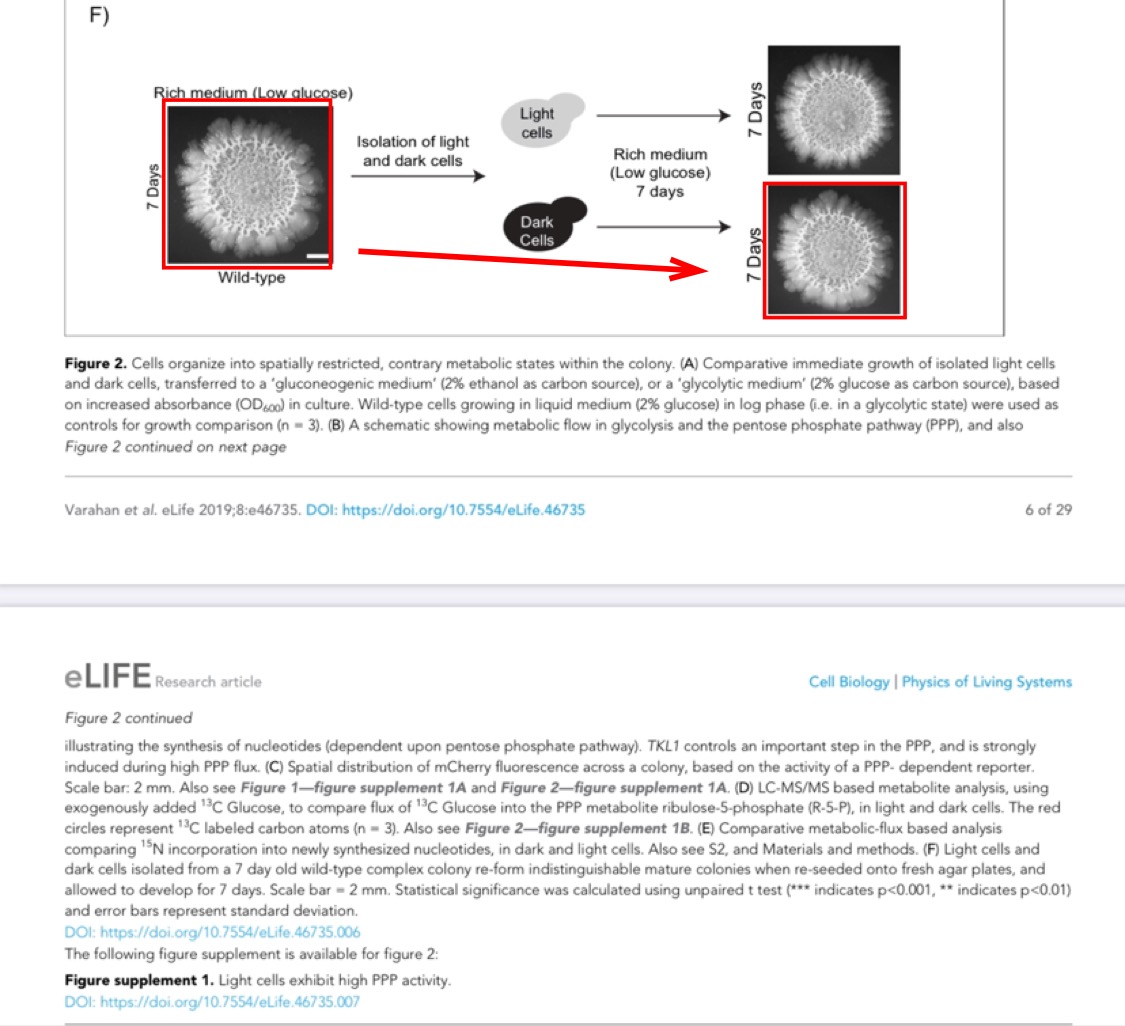
https://elifesciences.org/articles/65803
Varahan S, Walvekar A, Sinha V, Krishna S, Laxman S. 2019. Metabolic constraints drive self-organization of specialized cell groups. eLife 8:e46735. doi: 10.7554/eLife.46735.
Published 26, June 2019
In the published article, Figure 2F inadvertently used a second image of the wild-type colony instead of the dark cell inoculated colony. A corrected figure 2 is now shown. The updated image reiterates that a wild-type S. cerevisiae colony on an agar plate that is inoculated using cells from an overnight liquid culture (leftmost colony in Fig. 2F) is similar in morphology to a colony inoculated using only dark cells taken from the former colony (bottom right colony in Fig 2F) and similar to one inoculated using only light cells taken from the former colony (top right colony in Fig. 2F). There is no change to the conclusions made in our paper.
LikeLike
And today yet another paper of Arati Ramesh is flagged for data manipulation. The common authors with the NCB paper are Dolly Mehta and Arati Ramesh. The student who was made a scapegoat for the NCB paper is not there. Yet I am sure some people will find imaginative narratives to proclaim Arati’s innocence.
https://pubpeer.com/publications/7BBC0875C2CC1C1464A9F964C65719?fbclid=IwAR3Zo7otG6lVF6wXTmdPGM1PUGEMaDwZr0zoAm7Tur33JhvIfMQm-0fs4qc#1
LikeLike
You were perhaps right. Some people indeed found “imaginative narratives to proclaim Arati’s innocence.”. How honourable!
LikeLike